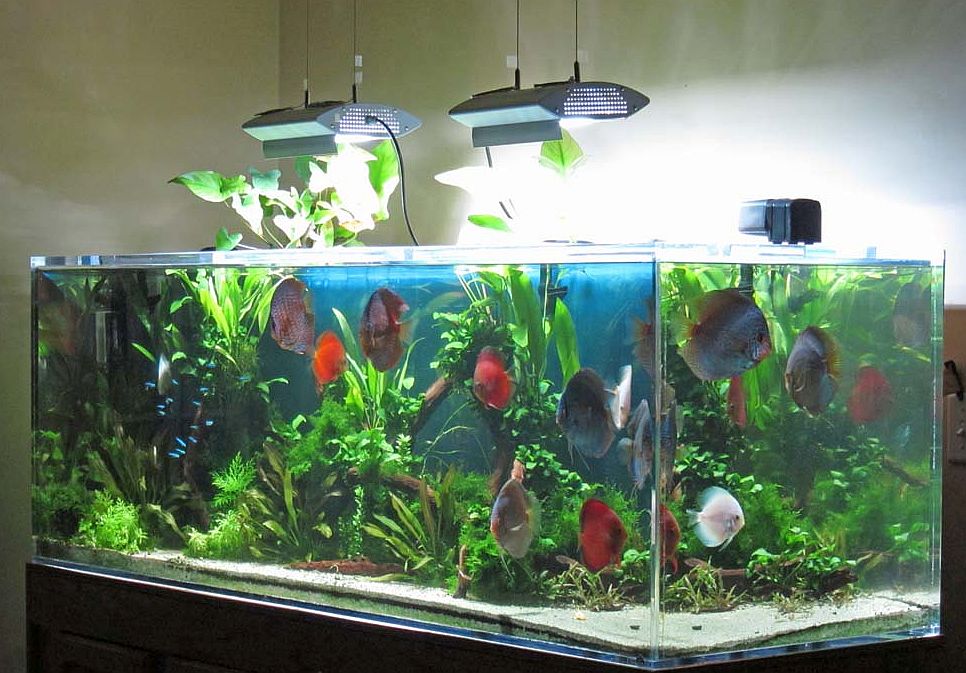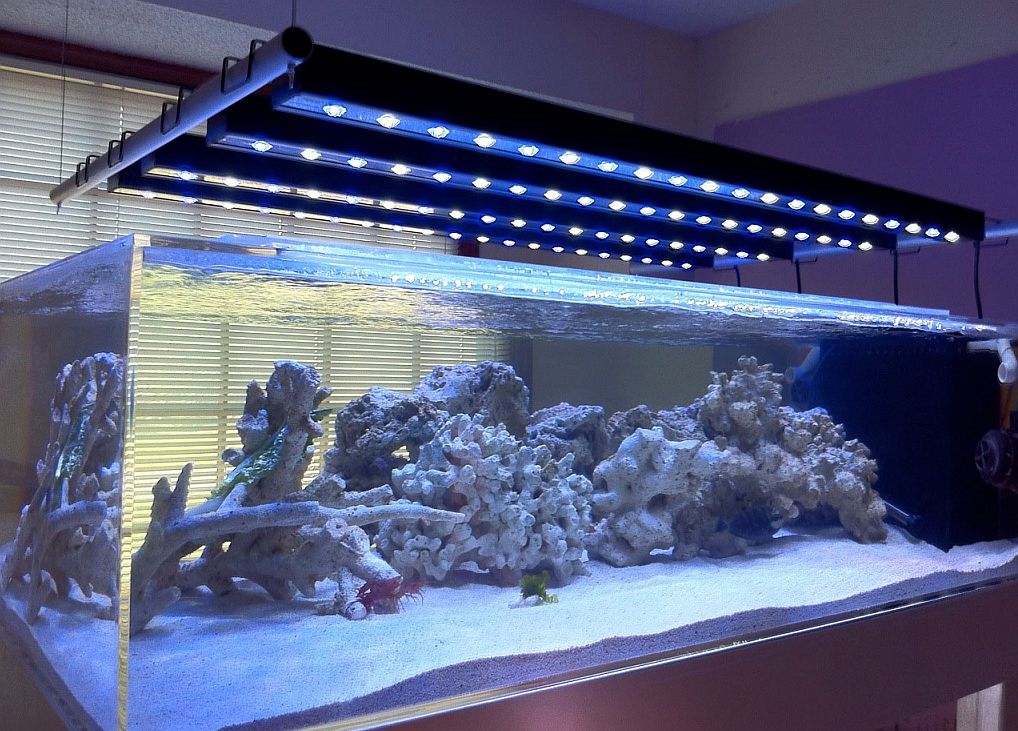Aquarium lighting is necessary for maintaining fish health and illuminating all types of tropical fish keeping aquariums.
Some types of marine reef aquariums or densely planted freshwater aquariums need specialized lighting to support the photosynthetic life forms that are housed in the tank.
Densely planted freshwater aquariums may also require a more specialized light source for plants to thrive.
To really encourage plant growth, densely planted freshwater aquariums should be provided with either high intensity compact fluorescent bulbs, high output fluorescent bulbs, or metal halide lamps.
Using high intensity lighting does have its cons. Most high intensity aquarium lighting systems produce much more heat than standard light sources and use more electricity.
- Freshwater Tanks:
Almost all freshwater aquarium lighting is now provided by either the screw in incandescent bulbs, clip in fluorescent tubes, or LED (Light Emitting Diode) lamps.
Until recently, incandescent lighting was used for many years in the tropical fish keeping hobby but has become less popular with the advent of lower heat producing and less energy consuming types of lighting.
Many hobbyists who still have the outdated incandescent light screw in bases in their tank hoods usually replace the incandescent bulbs with a compatible screw in base CFL (Compact Fluorescent Light) bulb.
The newer T2, T5, SHO, and LED bulbs produce even less heat and use considerably less electricity.
LED aquarium lighting systems are the most efficient for use in densely planted freshwater aquariums however, the T2, T5 and SHO are close second choices.
- Brackish Water Tanks:
Brackish water aquarium lighting is similar to that used in freshwater and densely planted tanks. Depending on the species that is being housed, brackish water aquariums may require UVB or infrared bulbs in addition to or separate from the above mentioned light sources.
Some brackish water nocturnal species and basking animals like turtles require infrared lighting to remain healthy.
- Marine Fish Only Tanks:
In most marine fish only aquariums, less intense lighting is used to illuminate the subjects in the tank, usually for aesthetics.
In addition for optimal viewing of the fish, the lower intensity lighting limits the growth of unwanted algae in the tank. In tropical reef aquariums, the opposite is true.
- Reef Tanks:
Reef tanks require the highest intensity lighting for the well being of photosynthetic corals, inverts, clams, etc. Aquarium lighting for reef tanks includes LED, fluorescent, metal halide lamps, plasma lamps and/or combinations of these types.
The most simple lighting setups use only a single lamp or lamps of one type. The more advanced reef lighting arrays include several types of lamps in several color and light spectrum.
The thinner T5 High Output fluorescent bulbs provide a much brighter and more powerful light source than the older, more commonly used VHO (Very High Output) fluorescent and CFL (Compact Fluorescent Lighting) lighting.
Metal halide bulbs are the most commonly used in reef aquariums today but they do not have the overall balanced effect of other types of lighting. Many halide lights replicate the intense shimmering bright tropical sun light that is found over natural coral reefs.
Metal halide lighting is available in a variety of light spectrum from 5,000k all the way up to 20,000k. This allows the tropical fish keeping enthusiast the ability to duplicate the requirements of a variety of corals and photosynthetic clams.
Because metal halide lighting does not have the overall spectrum of other types of lighting, many tropical fish keeping enthusiasts frequently use metal halide bulbs in conjunction with either compact fluorescent or T5 fluorescent bulbs.
The cons to using metal halide lighting is the fact that they use a lot of electricity and produce a great deal of heat.
In order to keep the reef tank water cool, most reef keepers will mount their metal halide lights at least a foot or so above the water surface or add chillers to their systems.
Modern reef light fixtures are now available with timers in “all in one” configurations for both daylight and nighttime viewing. These systems mimic daylight and lunar lighting for truly realistic displays. In order to keep these systems cool and maintain optimum efficiency, single or multiple fans are often built into the fixtures.
Usually LED lamps of up to 2 watts are used to replicate the glow of moonlight over the tank and recently, LED lamps in higher wattage s are being used to simulate daylight conditions.
LED lighting is more expensive initially, but use much less energy than other light sources. In addition, they are dimmable.
Because LED lights are limited to a narrow band of wave lengths, different colored LED lights must be used in an array to simulate the spectral range needed for the growth of corals.





